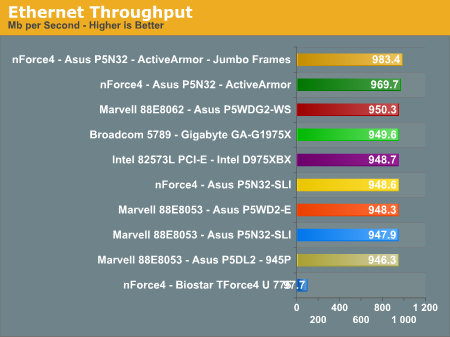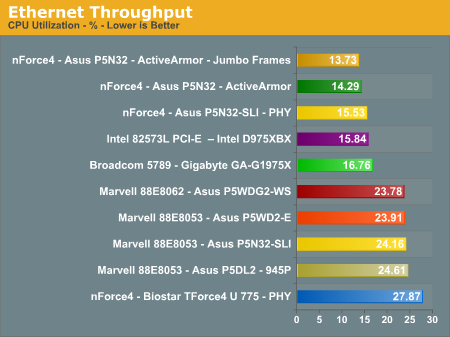NVIDIA nForce4 Ultra: Biostar's Performance Surprise
by Gary Key on February 16, 2006 12:05 AM EST- Posted in
- Motherboards
Ethernet Performance
The current motherboard test suite includes LAN performance measurements. All of these boards utilize PCI Express controllers with the only difference being the supplier of the core logic.
The Windows 2000 Driver Development Kit (DDK) includes a useful LAN testing utility called NTttcp. We used the NTttcp tool to test Ethernet throughput and the CPU utilization of the various Ethernet Controllers used on the Intel motherboards.
We set up one machine as the server; in this test, an Intel system with an Intel CSA Gigabit LAN connection. Intel CSA has a reputation for providing fast throughput and this seemed a reasonable choice to serve our Gigabit LAN clients.
At the server side, we used the following Command Line as suggested by the VIA whitepaper on LAN testing:
All standard Ethernet tests were performed with standard frames and the NVIDIA Active Armor suite disabled unless otherwise noted. Gigabit Ethernet supports Jumbo frames as well and provides a further reduction in CPU overhead. We added another test scenario in which ActiveArmor and Jumbo frames were enabled on the Asus P5N32-SLI Deluxe board via the 6.82 WHQL platform driver set. This is shown for illustrative purposes and shows the favorable impact of this technology.
The current motherboard test suite includes LAN performance measurements. All of these boards utilize PCI Express controllers with the only difference being the supplier of the core logic.
The Windows 2000 Driver Development Kit (DDK) includes a useful LAN testing utility called NTttcp. We used the NTttcp tool to test Ethernet throughput and the CPU utilization of the various Ethernet Controllers used on the Intel motherboards.
We set up one machine as the server; in this test, an Intel system with an Intel CSA Gigabit LAN connection. Intel CSA has a reputation for providing fast throughput and this seemed a reasonable choice to serve our Gigabit LAN clients.
At the server side, we used the following Command Line as suggested by the VIA whitepaper on LAN testing:
Ntttcpr -m 4 ,0,‹server IP› -a 4 -l 256000 -n 30000On the client side (the motherboard under test), we used the following Command Line:
Ntttcps -m 4 ,0,‹client IP› -a 4 -l 256000 -n 30000At the conclusion of the test, we captured the throughput and CPU utilization figures from the client screen.


All standard Ethernet tests were performed with standard frames and the NVIDIA Active Armor suite disabled unless otherwise noted. Gigabit Ethernet supports Jumbo frames as well and provides a further reduction in CPU overhead. We added another test scenario in which ActiveArmor and Jumbo frames were enabled on the Asus P5N32-SLI Deluxe board via the 6.82 WHQL platform driver set. This is shown for illustrative purposes and shows the favorable impact of this technology.










31 Comments
View All Comments
jamesbond007 - Thursday, February 16, 2006 - link
Haha! Way to go, Gary. You have a fan base! =PGary Key - Thursday, February 16, 2006 - link
Thanks for kind words everyone. I will post a short update to this article in a couple of days as the new bios results are looking promising in resolving some overclock and bios lockup issues.drewintheav - Thursday, February 16, 2006 - link
Gary is awesome! :)Zebo - Thursday, February 16, 2006 - link
I love Gary can't we get him writing articles people will read? Intel/biostar - common.. you'll get 1000 page hits max and 3/4 of them are because Gary wrote it!:PGooger - Thursday, February 16, 2006 - link
Not too bad if you want a P4, but for me I am avoiding nVIDIA Chipsets except when it comes to AMD products. Go Go ULi!DigitalFreak - Thursday, February 16, 2006 - link
Uh, you mean Go Go Nvidia, since they own ULi now...Googer - Thursday, February 16, 2006 - link
Finaly Intel Gets Hypertransport on their chips, like it or not HTT probably is becoming a standard that Intel might have to adopt sooner or later.DigitalFreak - Thursday, February 16, 2006 - link
This has nothing to do with Intel. Nvidia uses HT to communicate between their north and south bridges. They've done it with all their Intel chipsets so far.Googer - Thursday, February 16, 2006 - link
Since the noth bridge has HTT, in theory you could connect an nVIDIA based nFORCE north bridge to a ULi or nVIDIA AMD north bridge and have one of several things:1) A dual CPU system- One Intel Pentium M/4 and One AMD 64 CPU running on the same motherboard simultaniously. The OS might need to be re-written so that multi-threaded applications only use one processor. Linux prehaps?
2) AMD 64 Could get Quad Channel RAM higher.
3) You could ADD a ULi M1567 Southbridge to get True AGP with that PCI-express SLI.
4) You could possibly mix and match chipsets. VIA K8T8xx with one of AMD's north/south bridges and an nFORCE Intel Editon.
You could possibly Connect the AMD 64 Directly (using it's own HTT link) in to the the P4 north bridge with no need to use the chipset designed for the A64.
HTT on Intel means a whole new world of possibilites!
Furen - Thursday, February 16, 2006 - link
Huh? How is Intel getting hypertransport on its chips? HT is a standard but I dont think Intel will ever adopt it because of its pride, more than anything else. It truly doesn't matter though, since HT is just a data transport and using any other data transport gives you the same results as long as it is used in a similar configuration.